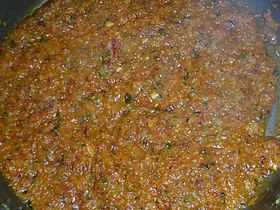Sofrito
Not to be confused with Italian Soffritto, which is a kind of Mirepoix.

Sofrito or refogado is a sauce used as a base in Spanish, Portuguese, and Latin American cooking. Preparations vary, but sofrito typically consists of aromatic ingredients cut into small pieces and sauteed or braised in cooking oil.
In Spanish cuisine, sofrito consists of garlic, onion, peppers and tomatoes cooked in olive oil. This is known as refogado or sometimes as estrugido in Portuguese-speaking nations, where only onions and olive oil are essential, garlic and laurel being the other most common ingredients. It is known as sofregit in Valencian cuisine, epis in Haitian cuisine and ginisá in Filipino cuisine.
Other meanings and versions of sofrito
In Brazilian cuisine, the verb refogar encompasses also the dishes that are fried in vegetable oil before being e.g. boiled or steamed, even when the actual fried seasoning is not there. As such, a rice pot that has been heated for long in vegetable oil in order to "seal" it before being boiled is technically refogado, even if it is consumed plain, without garlic or any other vegetable or meat addition. Actually, the Portuguese verb refogar is literally "to fire i.e. heat repeatedly", thus it is actually a logical conclusion.
In Caribbean cuisine, sofrito is a seasoned lard and functions as a base for many traditional dishes, but prepared differently from the method described above. Lard (acquired from rendering pork fat) is strained, and annatto seeds are added to colour it yellow, and later strained out. To the colored lard is added a ground mixture of cured ham, bell pepper, chile pepper, and onion; after this, mashed coriander leaves (cilantro) and oregano leaves are added. Garlic cloves are added in a tea ball, and the sauce is simmered for half an hour.[1] The term also refers to a number of related sauces and seasonings in the Caribbean and Central and Latin America.
In Cuban cuisine, sofrito is prepared in a similar fashion, but the main components are onions, garlic, and green bell peppers. It is a base for beans, stews, rices, and other dishes, including ropa vieja and picadillo. Other secondary components include, but are not limited to, tomato sauce, dry white wine, cumin, bay leaf and cilantro. Chorizo (sausage), tocino (salt pork) and ham are added for specific recipes, such as beans.
In Dominican cuisine, sofrito is also called sazón, and is a liquid mixture containing vinegar, water and sometimes tomato juice. A sofrito or sazón is used for rice, stews, beans, and other dishes. A typical Dominican sofrito is made up of very finely chopped green, red and yellow bell peppers, red onions, garlic, ground oregano, apple cider vinegar, tomato paste, water, and cilantro. Ingredients vary and can change, for instance cubanelle peppers can substitute for bell peppers, celery can replace onions and parsley or culantro can be used in place of cilantro.
In Greek cuisine, the term refers to a specific dish native to, and almost exclusively to be found on, the island of Corfu. Sofrito is a veal steak slow-cooked in a white wine, garlic and herb sauce and is usually served with rice.
In Puerto Rican cuisine, it is mostly used when cooking legumes, rice dishes, sauces, soups and stews. The two main ingredients that give Puerto Rican sofrito its characteristic flavor are recao (culantro) and ají dulce, but cubanelle peppers, roasted red pepper, yellow onions, garlic, plum tomatoes and cilantro, are also added. Sofrito is traditionally cooked with olive oil or annatto oil, tocino (bacon), salted pork and cured ham. A mix of stuffed olives and capers called alcaparrado is usually added with spices such as bay leaf, cumin, sazón and adobo.
In Colombian cuisine, sofrito is called hogao or guiso, and it is made mostly of tomato, onion and coriander, and sometimes garlic; it is mostly used when cooking stews, meats, rice, and other dishes.
In the Sephardi Jewish cuisine of the eastern Mediterranean and the Maghreb, the term sofrito emphasizes a method of cooking rather than a specific combination of aromatics. Chicken sofrito is chicken sautéed with garlic, turmeric, and cardamom and simmered in a small volume of water or stock with lemon juice, or simmered with all these ingredients without prior sautéing. The second method can also be used in cooking veal, calves' brains or fish.
In the Haitian cuisine of the Caribbean, epis is a combination sauce made from cooked peppers, garlic, and herbs, particularly green onions, thyme, and parsley. It is used as a basic condiment for rice and beans and is also used in stews and soups.
See also
References
- Roden, Claudia, A New Book of Middle Eastern Food: London 1986 ISBN 0-14-046588-X
- Roden, Claudia, The Book of Jewish Food: New York 1997, London 1999 ISBN 0-14-046609-6
External links
- Sofrito About the foodways and culinary history of sofrito.
- Sofrito Recipe as made in Cuba
- Puerto Rican Sofrito recipe
- Dominican Sofritos
| Wikibooks Cookbook has a recipe/module on |